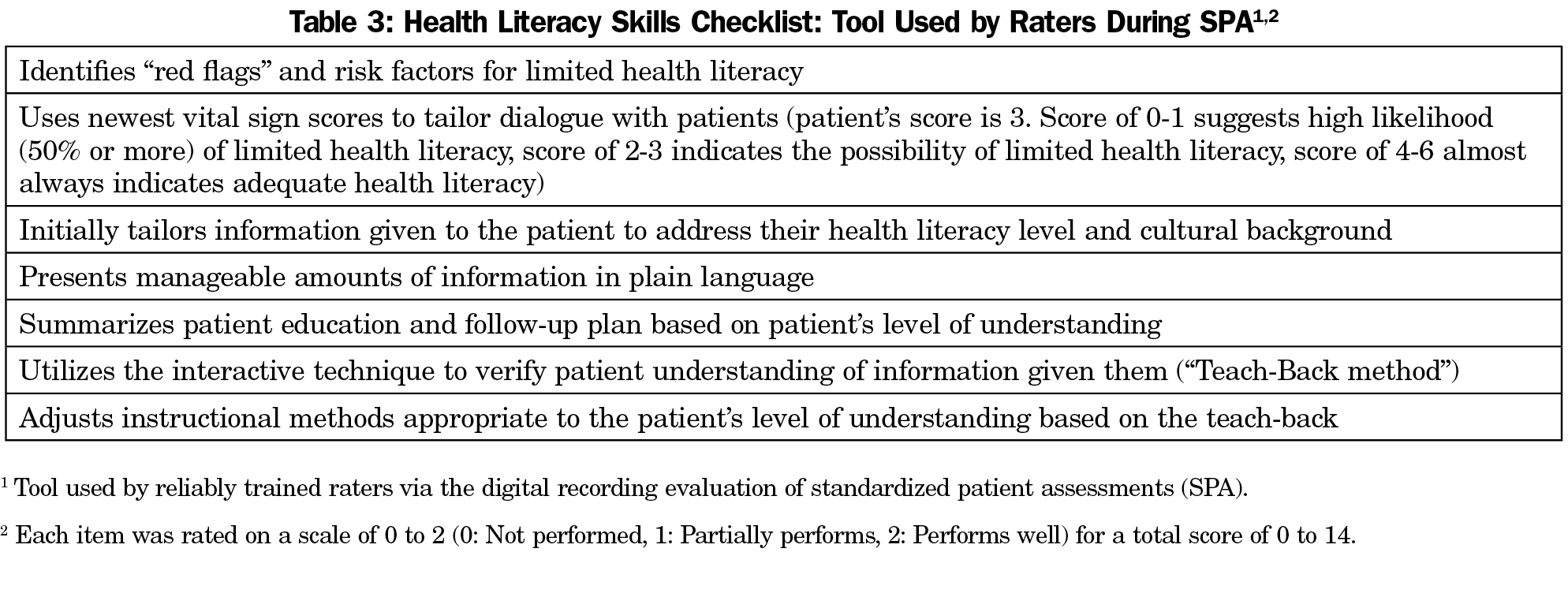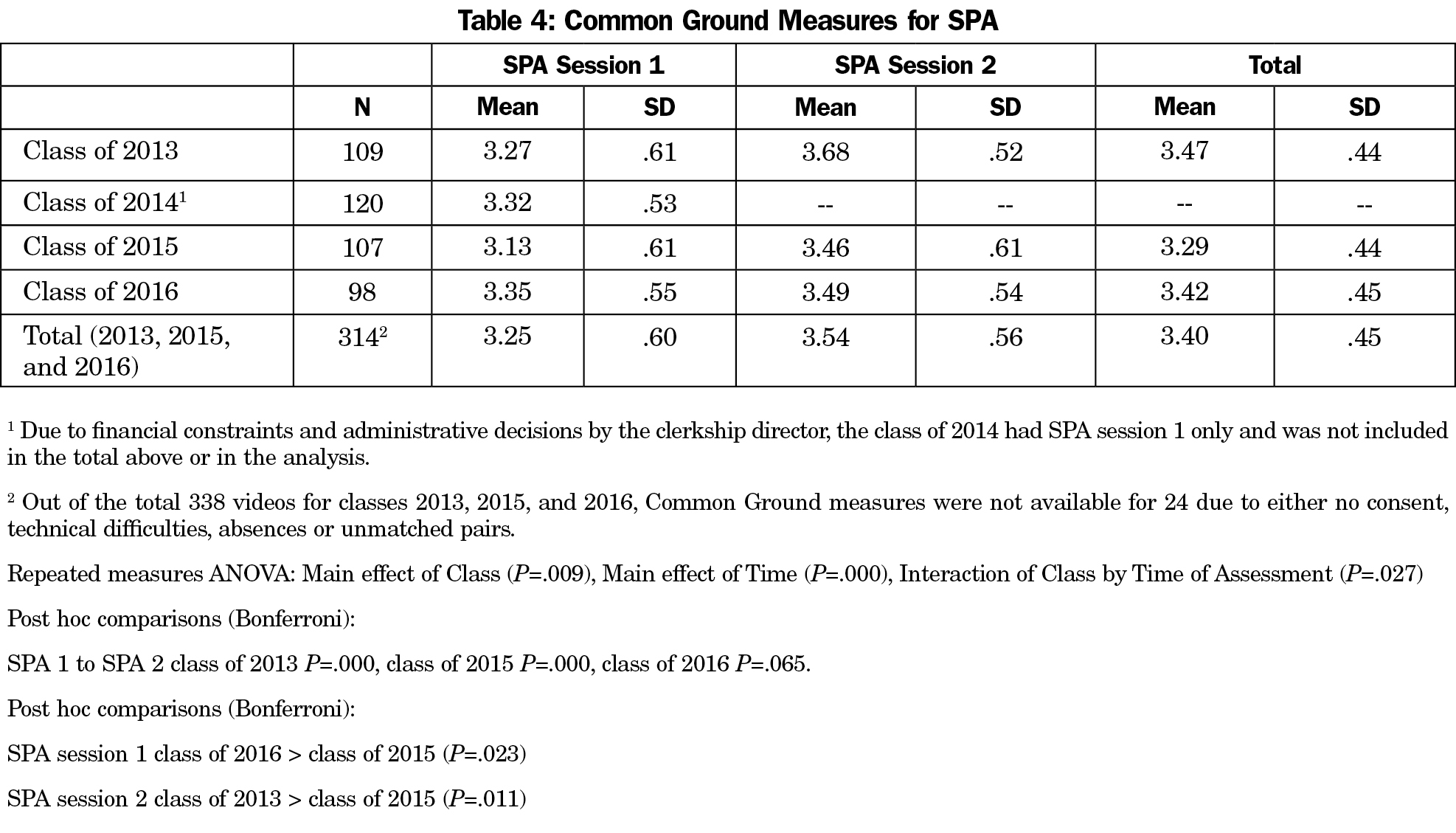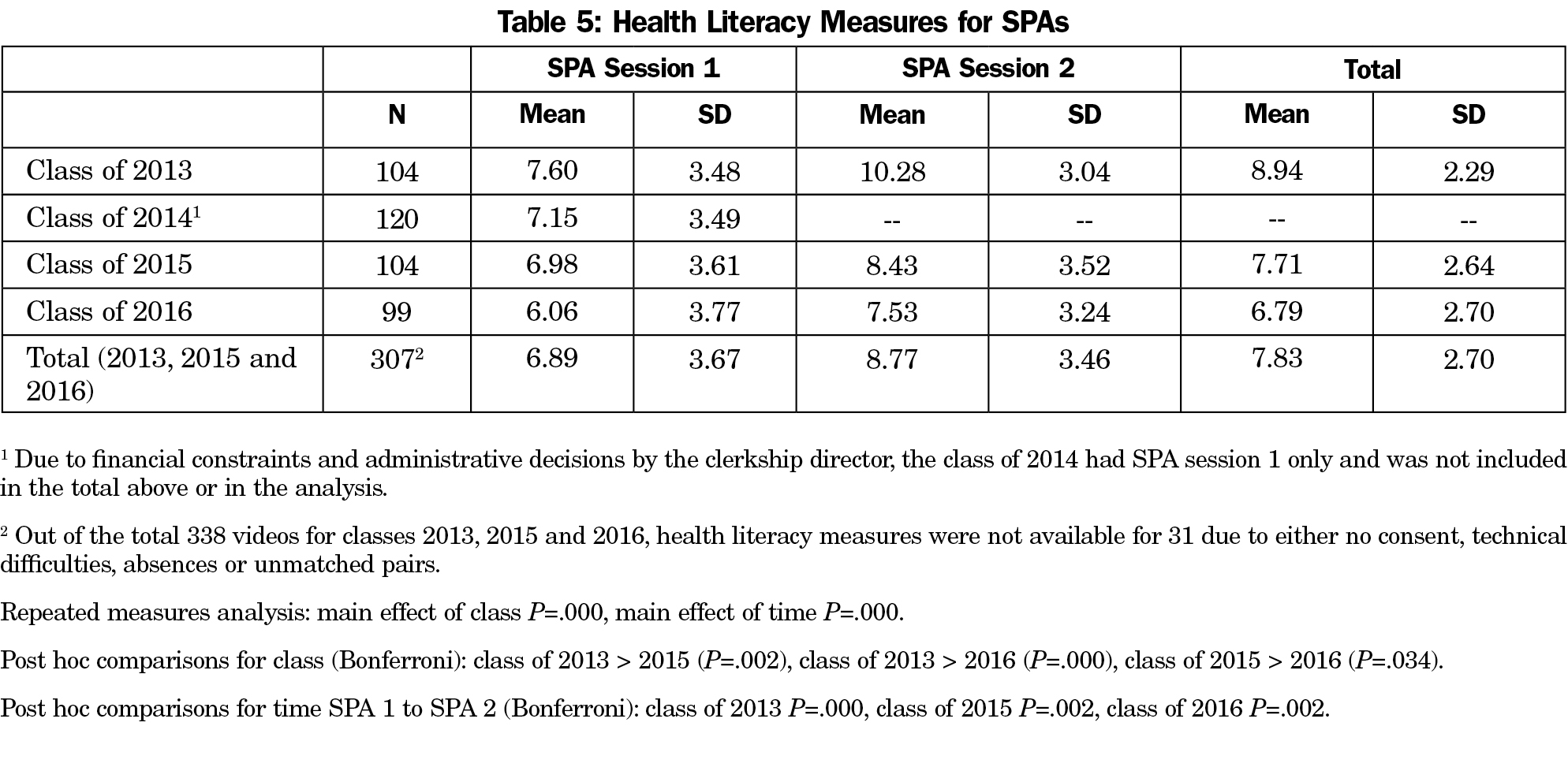Background and Objectives: Patients’ health literacy is a growing concern as patients are expected to perform more self-care. While many US schools implement health literacy in their curricula, time spent on the topic ranges from 0 to 8 hours and is largely didactic. Evaluation of health literacy skills is not well defined. The effectiveness of a health literacy curriculum for third-year medical students was evaluated by two standardized patients assessments (SPAs).
Methods: All third-year medical students complete a required 4-week clerkship in family medicine. After participating in seminars on patient-centered communication, health literacy, mindfulness, implicit bias, and chronic disease management, students complete SPA-1. Students also work in two team-based teaching clinics with chronic disease patients with limited health literacy and receive faculty feedback. At week 4, students complete SPA-2. Six raters evaluated all video-recorded SPA performances using the Common Ground validated instrument and a tailored health literacy skills checklist.
Results: Using SPAs and reliably-trained nonclinical raters is an effective method for training and evaluating students about health literacy. Two classes (2013 and 2015) had significant improvement in Common Ground core skills from SPA-1 to SPA-2. For all classes, a small but significant increase in student use of health literacy checklist was seen from SPA-1 to SPA-2.
Conclusions: Didactic sessions prepare students to demonstrate competence on Common Ground and health literacy skills. Improvements in students’ health literacy and communication skills are feasible in a 4-week clerkship utilizing the curriculum and evaluation process described.
Increasingly complex health systems necessitate patients learn and routinely perform self-care skills. Recognizing and improving patients’ health literacy has emerged as a central health concern. The Institute of Medicine defines health literacy as “the degree to which individuals have the capacity to obtain, process, and understand basic health information and services needed to make appropriate health decisions.”1 Ninety million adults have limited health literacy and 75% do not disclose this to providers.2 These patients are likely to face worse outcomes, use services less effectively, and among elderly persons and those in rural areas, experience poorer health and higher mortality.3,4
Standardized patient assessments (SPAs) provide for direct observation, training, and evaluation of student-patient interactions during histories, physical examinations, and wrap-up. SPAs offer objective data on learner performance.5,6 The SPA performance evaluation is enhanced when paired with evaluations by trained raters.7 Student performance in a 32-hour health literacy curriculum using interactive seminars, patient-centered communication, and health literacy skills was assessed with SPAs.
Participants included 435 third-year medical students completing a required 4-week clerkship in family medicine at the Wake Forest School of Medicine (WFSM) for the graduating classes of 2013 to 2016. Participants signed informed consents approved by the WFSM Institutional Review Board. In week 1, students attend five case-based seminars focused on recognizing problems and solutions associated with low health literacy (Table 1).8-23 The curriculum includes two team-based teaching clinics (TBTCs). Paired students participate in the care of faculty members’ continuity patients with chronic diseases in 4-hour TBTCs. Students are evaluated during two 20-minute SPAs that include a focused interview, exam, treatment plan, and completing a “subjective, objective, assessment, and plan” (SOAP) note.
Training and Instruments
Eight faculty received training in the Common Ground model and health literacy skills curriculum. The Common Ground instrument addresses six criteria-based, patient-centered skills. Interview skills are measured by a global rating that incorporates comprehensive criteria for SPA (Table 2). In the original validation, the interrater reliability was 0.85 for the global rating and 0.92 for the overall checklist assessment.8
To evaluate health literacy competency, we used seven questions from the US Health Resources and Services Administration (HRSA) health literacy website (Table 3).24 Reliably trained raters scored students’ performance for SPA via digital recordings. Three times annually, raters received iterative feedback to assure that scoring was consistent with benchmarking.
Data Collection and Analysis
After video recording, SPA data was deidentified. Reliably trained raters evaluated both performances using the Common Ground instrument8 and completed the health literacy skills checklist (Table 3). Paired Common Ground scores and health literacy checklists were evaluated for differences between SPA-1 and SPA-2 using SPSS.25 Repeated measures analyses of variance were performed separately for the Common Ground and health literacy measures. SPA-1 vs SPA-2 was a within-subject variable and student class was a between-subject variable. Pearson’s correlation was used to correlate Common Ground global scores and health literacy scores.
Participants were medical students in the classes of 2013 (n= 109), 2014 (n=120), 2015 (n=107), and 2016 (n= 98). Students had an average age of 26.8 years (range 24 to 43), and 54% of students were men. Overall, 72% of students were white, 11% African American, 8% Asian, and 9% other. For the classes of 2013, 2015, and 2016, 314 of 338 (93%) videos had both SPA sessions (data not captured for class of 2014 SPA-2).
A health literacy curriculum with SPAs using trained raters near the beginning and at the end of the clerkship was implemented. After SPA-1, and receiving 8 hours of training with health literacy and communication components, students’ global scores were in the low competent range on Common Ground and on the health literacy skills checklist. Common Ground scores analyses revealed a main effect of class, a main effect of first and second SPA sessions, and an interaction between class and session (Table 4). The classes of 2013 and 2015 showed significant improvements from the first to the second SPA session (Table 4). The class of 2016 improved, but the difference was not significant.
Health literacy scores showed significant main effects of class and SPA-1 versus SPA-2 (Table 5). Post hoc tests showed all classes had improved scores for health literacy skills from SPA-1 to SPA-2, attributed to communication skills. Post hoc examination of the main effect of class (SPA scores averaged across both sessions) revealed that the class of 2013 had higher health literacy scores than the other classes combined across both SPAs. The class of 2015 had higher average scores than the class of 2016. The Common Ground instrument scores were positively correlated with health literacy scores at each SPA session (Pearson correlation .45 SPA-1, .50 SPA-2).
Training medical students to assess health literacy is essential for effective patient communication. The curriculum offers a range of activities focused on the attitudes, knowledge, and skills for a learner to effectively create care plans with patients of diverse backgrounds and health literacy levels. The unbiased raters’ assessments using a validated scale increases confidence in the results. Our pool of raters remained stable over time, maintained their enthusiasm, and demonstrated sustained ownership regarding the success of this curriculum. Between SPA sessions, students participated in two TBTCs. Thereafter, both communication and health literacy scores increased from SPA-1 to SPA-2 for the classes of 2013, 2015, and 2016.
One limitation of this research is that the clerkship directors preferred an introduction to curriculum before SPA-1 for students to learn health literacy knowledge and skills before being evaluated. Health literacy and communication seminars are provided in the first 2 days of the clerkship. While we do not have a true baseline, scores between the two SPA sessions improved significantly.
This curriculum provided a robust medical student experience designed to improve care for patients with limited health literacy. Rater training provides a structure that other medical schools could adopt to enhance their evaluation of students’ skills. Other programs could use the curriculum described with only the cost of training raters and standardized patients. Since patients are expected to perform increasing self-care, learners need to know what patients understand in order to learn how to communicate effectively.
Acknowledgments
We gratefully acknowledge the editorial assistance of Karen Klein, MA, in the Wake Forest Clinical and Translational Science Institute (UL1 TR001420; PI: Li). We are deeply grateful for the sustained commitment of our video raters over the years of this project. Without their passion for this work, attention to detail, and continued willingness to be recalibrated, this project would not have been possible.
We warmly acknowledge the significant contributions that Dr Forrest Lang made to our patient-centered communications curriculum.
Financial Support: HRSA Grant D56HP20779, 5-year educational grant awarded in 2010 with a 1-year, no-cost extension awarded in 2015.
References
- Institute of Medicine. Report Brief. Health Literacy: A Prescription to End Confusion. Washington, DC: National Academies Press; 2004.
- Weiss BD. Health Literacy and Patient Safety: Help PatientsU. 2nd ed. Chicago: American Medical Association; 2007.
- Berkman ND, Sheridan SL, Donahue KE, Halpern DJ, Crotty K. Low health literacy and health outcomes: an updated systematic review. Ann Intern Med. 2011;155(2):97-107.
https://doi.org/10.7326/0003-4819-155-2-201107190-00005.
- Sun LH. Rural Americans are more likely to die from the five top causes of death. Boston Globe. January 12, 2017. https://www.bostonglobe.com/news/nation/2017/01/12/rural-americans-are-more-likely-die-from-top-causes-death/FFPY2khJWo0ivXzBmC3gqO/story.html. Accessed January, 2017.
- Colliver JA, Swartz MH, Robbs RS, Cohen DS. Relationship between clinical competence and interpersonal and communication skills in standardized-patient assessment. Acad Med. 1999;74(3):271-274.
https://doi.org/10.1097/00001888-199903000-00018.
- Petrusa ER. Taking standardized patient-based examinations to the next level. Teach Learn Med. 2004;16(1):98-110. https://doi.org/10.1207/s15328015tlm1601_19.
- Marion GS, Davis SD, Hairston JM, et al. Using standardized patient assessments to evaluate a health literacy curriculum. Poster presented at STFM Conference on Medical Education; Feb. 5-8, 2015; Atlanta, Georgia.
- Lang F, McCord R, Harvill L, Anderson DS. Communication assessment using the common ground instrument: psychometric properties. Fam Med. 2004;36(3):189-198.
- Carney PA, Palmer RT, Fuqua Miller M, et al. Tools to assess behavioral and social science competencies in medical education; a systematic review. Acad Med. 2016;91(5):730-742.
https://doi.org/10.1097/ACM.0000000000001090.
- Brega AG, Barnard J, Mabachi NM, et al. Health Literacy Universal Precautions Toolkit. 2nd ed. Rockville, MD: Agency for Healthcare Research and Quality; 2015, http://www.ahrq.gov/professionals/quality-patient-safety/quality-resources/tools/literacy-toolkit/healthlittoolkit2.html. Accessed January, 2017.
- Weiss, BD. Health literacy and patient safety: help patients understand [DVD]. Chicago: AMA Foundation, 2007.
- Weiss BD, Mays MZ, Martz W, et al. Quick assessment of literacy in primary care: the newest vital sign. Ann Fam Med. 2005;3(6):514-522. https://doi.org/10.1370/afm.405.
- Kirk JK, Davis SW, Hairston J, Melius K, Marion GS. Medical student health literacy perspectives and experiences. J Fam Med Dis Prev. 2015;1:018. http://clinmedjournals.org/articles/jfmdp/journal-of-family-medicine-and-disease-prevention-jfmdp-1-018.pdf. Accessed January 2017.
- Greenwald AG, McGhee DE, Schwartz JL. Measuring individual differences in implicit cognition: the implicit association test. J Pers Soc Psychol. 1998;74(6):1464-1480.
https://doi.org/10.1037/0022-3514.74.6.1464.
- Heider JD, Skowronski JJ. Improving the predictive validity of the implicit association test. N Am J Psychol. 2007;9:53-76.
- Sriram N, Greenwald AG. The brief implicit association test. Exp Psychol. 2009;56(4):283-294.
https://doi.org/10.1027/1618-3169.56.4.283.
- McCann WJ, Marion GS, Davis SW, Crandall SJ, Hildebrandt CA. Applied relaxation and applied mindfulness (ARAM): A practical and engaging approach for mind-body regulation training in medical education. Ann Behav Sci Med Educ. 2013;19(2):10-15. https://doi.org/10.1007/BF03355250.
- American Diabetes Association. Standards of Medical Care in Diabetes – 2011. Diabetes Care 2011;34 (Suppl. 1).
- American Diabetes Association. Standards of Medical Care in Diabetes – 2012. Diabetes Care 2012;35 (Suppl. 1).
- American Diabetes Association. Standards of Medical Care in Diabetes – 2013. Diabetes Care 2013;36 (Suppl. 1).
- American Diabetes Association. Standards of Medical Care in Diabetes – 2014. Diabetes Care 2014;37 (Suppl. 1).
- American Diabetes Association. Standards of Medical Care in Diabetes – 2015. Diabetes Care 2015;38 (Suppl. 1).
- Marion GS, Hildebrandt CA, Davis SW, Marín AJ, Crandall SJ. Working effectively with interpreters: a model curriculum for physician assistant students. Med Teach. 2008;30(6):612-617.
https://doi.org/10.1080/01421590801986539.
- US Department of Health and Human Services. Health Literacy. HRSA. http://www.hrsa.gov/publichealth/healthliteracy. Accessed January 2017.
- IBM SPSS Statistics for Windows. Version 22.0. Armonk, NY: IBM Corp; 2013.








There are no comments for this article.